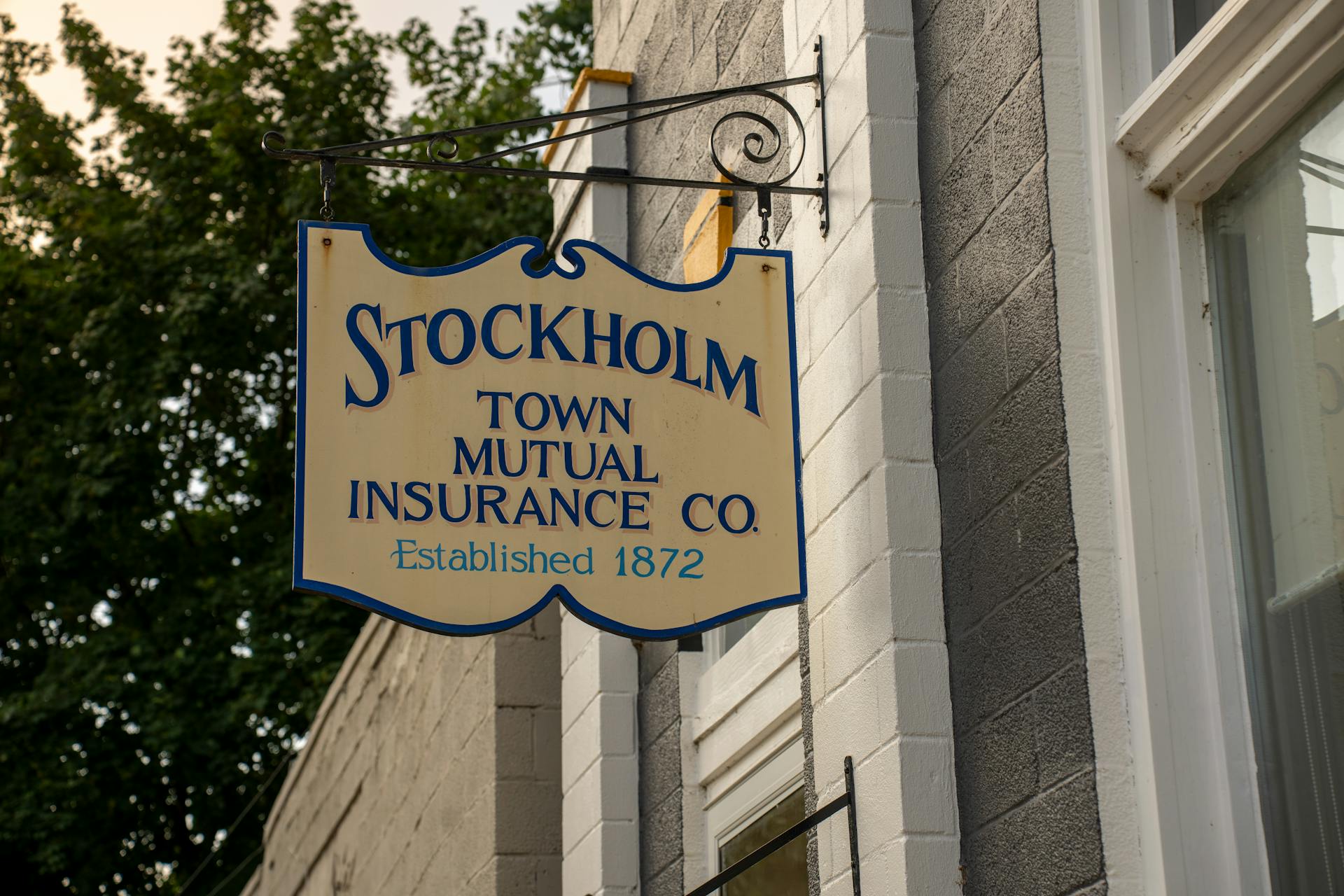
Business liability insurance is a crucial investment for any company, and understanding its cost is essential for making informed decisions. The cost of business liability insurance can range from $500 to $5,000 per year, depending on the industry, location, and coverage limits.
Small businesses typically pay less, around $500 to $2,000 per year, while larger companies may pay upwards of $5,000 or more. This variation is due to the complexity of the business and the level of risk involved.
Factors such as the type of business, number of employees, and location all contribute to the final cost. For example, a retail business in a high-risk area may pay more than a similar business in a low-risk area.
Explore further: Insurance Cover on Business - Merchant Services
What You Need to Know
You need to know that small business liability insurance is a type of insurance policy that covers legal expenses when a customer claims they suffered loss, bodily injury, or personal property damage as a result of your mistake or negligence.

General liability insurance is a common type of policy that covers costs if a customer is injured or suffers damage to personal property while doing business at your location. It's also known as commercial general liability insurance.
Product liability insurance covers claims of harm or illness resulting from a product defect or an error in product instructions, warnings, or labels. This type of insurance is crucial if you manufacture or sell products.
Professional liability insurance, also called errors and omissions insurance (E&O), is for handling claims arising from something you do wrong or something you neglect to do. This type of insurance is typically for professionals like lawyers, doctors, and accountants.
A customer slipping and falling on your premises is just one example of a situation where general liability insurance can help. You could also be liable if you make a calculation error that results in a customer losing a significant amount of money.
Here are some common scenarios where business liability insurance can help:
- A customer slips and falls on your premises.
- You make a calculation error that results in a customer losing a significant amount of money.
- You forget to give an important piece of advice, which leads to poor outcomes for your customers.
- You give inaccurate information, which causes a customer to suffer loss or harm.
- You do not fulfill all contractual obligations for a project or assignment.
- A repair you perform fails and causes property damage or personal harm.
- You accidentally cause property damage when working in a customer’s home.
- One of your products malfunctions and results in loss, harm, or property damage.
According to Forbes, 90% of small business owners aren’t sure they have enough insurance coverage to protect them financially if a customer files a claim. This highlights the importance of understanding your insurance needs and getting the right coverage.
Cost Factors

Business liability insurance costs can vary significantly based on several factors. The average monthly cost of general liability insurance is $42, while a business owner's policy (BOP) costs around $57 per month.
A business's location plays a significant role in determining insurance costs. Rates tend to be higher in highly populated areas and locations with increased claims. For example, general liability typically costs more in areas with a high risk of accidents or property damage.
The size of your business and revenue also impact insurance costs. Businesses with large customer bases and significant sales revenue have a higher probability of claims, making them more expensive to insure. This is reflected in the fact that a business with higher revenue may incur more risks and pay more for insurance, such as a manufacturer that expanded its factory and hired more people.
Here are some of the key factors that affect small business liability insurance costs:
- Your industry: Businesses in high-risk industries like construction, healthcare, and manufacturing pay more for insurance.
- The size of your business: Businesses with large customer bases and significant sales revenue have a higher probability of claims.
- How long you've been in business: Established businesses that take proactive measures to reduce the risk of claims may pay less than new businesses.
- Your revenue: Small business liability insurance is more expensive for businesses with high sales volume.
- Your location: Businesses in areas where liability claims occur more often generally pay more for insurance.
- Your claims history: Insurance companies may see businesses with a higher-than-average number of prior liability claims as high risk and charge more.
- The coverage options you choose: Policies with higher limits of liability and lower deductibles are more expensive.
Location

Your location can significantly impact the cost of small business liability insurance. Businesses in highly populated areas tend to pay more for insurance due to a higher likelihood of claims.
The size of your location also plays a role, with bigger buildings increasing the risk of accidents and subsequently, insurance costs.
Businesses in areas with high crime rates or increased foot traffic may pay more for insurance that covers theft or customer accidents. This is particularly true for businesses in districts with expensive real estate, which can increase the cost of claims.
State laws also influence insurance costs, with most states requiring workers' comp insurance for businesses with employees and commercial auto insurance for business-owned vehicles.
Here's a list of states that have specific insurance requirements:
- Alabama
- Alaska
- Arizona
- Arkansas
- California
- Colorado
- Connecticut
- Delaware
- Florida
- Georgia
- Hawaii
- Idaho
- Illinois
- Indiana
- Iowa
- Kansas
- Kentucky
- Louisiana
- Maine
- Maryland
- Massachusetts
- Michigan
- Minnesota
- Mississippi
- Missouri
- Montana
- Nebraska
- Nevada
- New Hampshire
- New Jersey
- New Mexico
- New York
- North Carolina
- North Dakota
- Ohio
- Oklahoma
- Oregon
- Pennsylvania
- Rhode Island
- South Carolina
- South Dakota
- Tennessee
- Texas
- Utah
- Vermont
- Virginia
- Washington
- Washington, D.C.
- West Virginia
- Wisconsin
- Wyoming
Factors Affecting Costs
Business insurance costs can vary significantly depending on several factors. One key factor is the type of business insurance policy you choose, with professional liability or E&O insurance costing $61 per month on average.

Business property is another significant factor, with premiums influenced by the value of the insured property and its condition. For example, a business with high-value equipment or inventory may pay more for insurance.
Business income also plays a role, with higher revenue businesses typically paying more for insurance due to increased risks. A manufacturer that expands its factory and hires more employees, for instance, may see an impact on its general liability and workers' comp rates.
The number of employees is also a crucial factor, with more employees leading to a higher risk of work-related accidents and associated medical expenses. In fact, a business with many employees may pay significantly more for workers' comp insurance.
Business structure can also impact insurance costs, with sole proprietorships and LLCs often paying less than S corporations. Additionally, a business's claims history can drive up insurance rates, making risk management essential.
Here are some specific factors that can affect small business liability insurance costs:
• Industry: Businesses in high-risk industries like construction, healthcare, and manufacturing pay more for insurance.
• Business size: Larger businesses with more customers and sales revenue tend to pay more for insurance.
Consider reading: How to Value an Insurance Book of Business

• Claims history: Businesses with a history of claims pay more for insurance.
• Coverage options: Policies with higher limits of liability and lower deductibles are more expensive.
• Business location: Businesses in areas with high crime rates or increased foot traffic may pay more for insurance.
• State laws: Some states require specific types of insurance, such as workers' comp or commercial auto insurance.
By understanding these factors, you can take steps to lower your small business liability insurance costs.
Recommended read: Business Insurance Claims Examples
Calculating Costs
Calculating the cost of small business insurance involves several key factors. Your insurance provider will typically calculate your premiums based on the size of your business, its location, and the type of work you do.
The size of your business is a crucial factor in determining your insurance rates. The average monthly premiums can give you a general idea of how much you could pay for coverage.
General liability insurance is often the least expensive type of coverage, with an average cost of $42 per month or $500 per year. This type of coverage is often bundled with commercial property insurance at a discount.
Curious to learn more? Check out: What Type of Business Insurance Do I Need
Time

Time plays a significant role in calculating costs, particularly when it comes to business experience. Newer businesses might pay more for insurance because they don’t have much experience.
An established safety record can lower your premium over time. This is because newer businesses are considered riskier, so they have to pay more to compensate for that risk.
Newer businesses are more likely to be involved in accidents or incidents, which increases their insurance costs.
For your interest: Can My Business Pay for My Car Insurance
How Is Calculated?
Calculating costs for small business insurance can be a complex process, but understanding the key factors that affect premiums can help you make informed decisions. Your insurance provider will typically calculate your premiums based on several different factors about your business.
The size of your business is a key factor in determining your insurance rates. Businesses with large customer bases and significant sales revenue have a higher probability of claims.
Location also plays a significant role in calculating costs. Businesses in areas where liability claims occur more often generally pay more for insurance. Building size also contributes to costs: a bigger location means more space in which accidents can occur.
Expand your knowledge: Is Bop Liability Coverage Claims Made

The type of work you do is another important factor. Businesses in industries where the risk of claims is higher pay more for insurance. These high-risk industries include construction, healthcare, and manufacturing.
A new business might pay more for insurance because they don’t have much experience. Over time, an established safety record could lower your premium.
Here's a quick look at the factors that affect the cost of general liability insurance coverage and other types of small business insurance:
Keep in mind that the average monthly costs listed above can give you a general idea of how much you could pay for coverage.
Adjusting Coverage Limits and Deductibles
Adjusting coverage limits and deductibles can significantly impact the cost of your small business liability insurance. Lowering your aggregate limits from $2 million to $1 million, for example, can lower your premium.
You can also increase your deductible amounts, which will lower your overall coverage, meaning you'll pay more out of pocket at the time of a covered loss. Make sure you're comfortable with your selected amounts prior to buying a policy.
A fresh viewpoint: Public Liability Insurance 10 Million

The right amount of insurance coverage depends on your business needs. You want coverage that'll cover a potential lawsuit, without buying more than you need. A typical general liability policy includes a per-occurrence limit of $1 million, which includes both legal and settlement costs.
The average deductible that Insureon customers select for general liability insurance is $500. If you can’t pay for it in a crisis, your insurance won’t activate to cover your liability claim.
Here's a breakdown of the two types of limits you'll typically see in a general liability insurance policy:
Policy Details
General liability insurance policies can pay out in cases of third-party bodily injuries, property damage, and personal and advertising injury.
These policies specifically cover your legal costs if someone accuses your business of causing harm, and can also cover medical payments for injuries that happen on your property.
Some policies may include product liability insurance coverage, which provides protection against claims that a product your business manufactured, delivered or sold caused harm to a person or property.
Here's a breakdown of the types of harm covered by general liability insurance:
- Third-party bodily injuries
- Third-party property damage
- Personal and advertising injury
This coverage can be a lifesaver for businesses, as it helps protect against costly lawsuits and unexpected expenses.
Policy Details

General liability insurance policies typically include two numbers: the per-occurrence limit and the aggregate limit. These limits can run from $250,000 to $2 million and more.
The per-occurrence limit is the maximum amount the insurance company will pay out for a single claim. A typical general liability policy includes a per-occurrence limit of $1 million, which includes both legal and settlement costs.
The aggregate limit is the total amount the insurer will pay out in a single year. A typical general liability policy includes an aggregate limit of $2 million.
Most Insureon customers choose $1 million / $2 million general liability insurance limits. You want coverage that'll cover a potential lawsuit, without buying more than you need.
If you can’t pay for the deductible in a crisis, your insurance won’t activate to cover your liability claim. The average deductible that Insureon customers select for general liability insurance is $500.
Lowering your aggregate limits from $2 million to $1 million, for example, is one way to lower your premium. You can also increase your deductible amounts.
Other Coverage

General liability insurance has a median cost of $42 per month, according to insurance marketplace Insureon. But coverage may be cheaper for low-risk businesses.
Workers' compensation insurance pays for medical costs, physical therapy, and lost wages while an employee recovers from a workplace injury. Policy costs are affected by the size of your workforce and the level of risk involved in their jobs.
Commercial auto insurance provides coverage similar to personal auto insurance for vehicles you use in your business. Premiums are based on the type and number of vehicles you have, how often and how far they're driven, and employee driving records.
Business interruption insurance is a good companion to property insurance, reimbursing you for lost income, payroll expenses, taxes, temporary relocation expenses, and rent, lease, or loan payments. Premiums depend on business size, revenue, property value, and industry.
Equipment breakdown insurance covers the cost of repairing or replacing damaged or malfunctioning equipment and reimburses you for related revenue loss. These policies also typically pay for inventory or property damage resulting from equipment breakdown.
A different take: Do Insurance Personal Property Riders Cover Lost

Crime insurance covers losses from business crimes like fraud, theft, or embezzlement and includes money, inventory, property, and business assets. Crime insurance premiums are priced according to your business type, the size of your workforce, and your employees' theft history.
Cybersecurity insurance is an important policy for businesses that handle sensitive customer or company data. These policies include coverage for costs related to data breaches or cyberattacks, such as incident investigation, risk assessment, ransomware payments, and lost revenue.
Here are some examples of other types of business insurance coverage you might need:
What Is a Policy?
A policy is a collection of insurance coverages that work together to protect your business.
Business owner's policies, for instance, typically include commercial property insurance, general liability insurance, and business interruption coverage.
A BOP won't cover professional liability insurance, which you'll need to purchase separately.
These coverages can vary from one insurer to another, but they often provide a comprehensive package for small businesses.
Frequently Asked Questions
How much does a $1 million dollar business insurance policy cost?
For a $1 million business insurance policy, the average monthly cost is around $42, with some paying as little as $30 or up to $60 per month. Learn more about your business insurance options and potential costs.
How much is a $2 million dollar insurance policy for a business?
A $2 million business insurance policy typically costs around $30 per month in premiums. This affordable rate can provide significant protection for your business.
How much is a $5 million dollar insurance policy for a business?
A $5 million business insurance policy typically costs between $375 to $525 per year, extending your existing liability coverage with an extra layer of protection.
How much is a liability insurance in California?
The average annual cost of liability insurance in California is around $575, which is comparable to the national average. Find out more about California's minimum liability insurance requirements and how to get the best rates.
Sources
- https://www.progressivecommercial.com/business-insurance/general-liability-insurance/general-liability-insurance-cost/
- https://www.insureon.com/small-business-insurance/cost
- https://www.berxi.com/resources/articles/small-business-liability-insurance-cost/
- https://www.investopedia.com/small-business-insurance-cost-7113408
- https://www.nerdwallet.com/article/small-business/general-liability-insurance
Featured Images: pexels.com


